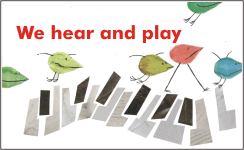
Click to return to the home page
The looseleaf format is helpful for several reasons.
1. Heavy piano books are difficult for small children to manage. With a looseleaf system they can carry to their lesson only those pages they really need.
2. Children are often not very careful with books, and the books fall from the piano and are damaged. The looseleaf format avoids this.
3. There are longer songs which require several pages. The process of turning the pages of a bound book often causes rhythmic problems. Looseleaf pages may be placed next to each other and turned quickly.
4. The teacher may keep most of the piano book, and give the student only the new pages for each lesson.
This may seem restrictive, but it is very practical. We experimented with this process for many years. If the teacher gives the student only the pages for their daily practice, the student will normally accept them without any trouble. But if the student has the entire book, they will often want to reject the teacher’s selections and make their own choices. This can be counterproductive, because children are not able to judge the difficulty of a piece— but if a teacher refuses to accept the child’s preference, this can cause frustration and disappointment. This becomes the beginning of an endless and meaningless struggle. Therefore, we think it is better to avoid such problems from the start.
The process can, in fact, be a very positive experience. As the child continues to receive more new pages in each lesson, they will be happy to see their book “growing up.”
5. The teacher may arrange the order of piano pieces to support a child’s individual progress.
Although the order of pieces in Book I should not be altered, from Book II onwards the teacher may reorder the pieces to accommodate each student’s individual needs. Some children may need more etudes, like the Beyer pieces, and others will prefer to play songs. Some children may have problems playing with both hands. For these and many other reasons, the teacher may want to rearrange the pieces to best help the student learn and grow..
Preface by Christopher Aruffo
Foreword by Naoyuki and Ruth Taneda
Frequently Asked Questions about Absolute Pitch